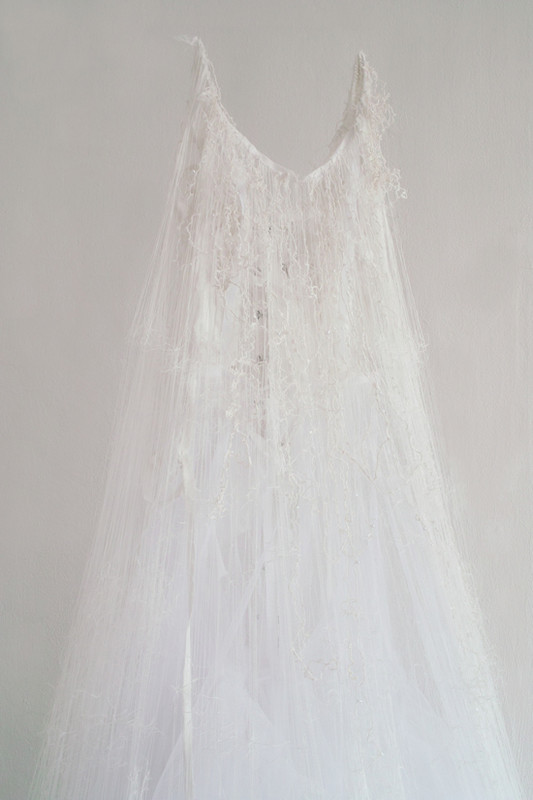Kaoru Hirano
29 Jun - 28 Jul 2012
KAORU HIRANO
Re-Dress
29 June - 28 July 2012
This "Re-Dress" exhibition consists of an installation of works made primarily from wedding dresses. The used wedding dresses were obtained from Japanese wedding gown rental outlets.
These dresses, which had been worn by many people, were unraveled and initially reduced to meaningless thread. Through Hirano's handiwork, they then take forms possessing hints of having once been worn by someone.
Kaoru Hirano creates her works by unraveling once-worn clothing until it is reduced to thread, and then joining it back together, giving visual form to that which is usually invisible--extinguishing of the memories and presence of the original wearer, followed by rebirth.
As indicated by this exhibition's title, "Re-Dress," Hirano is attempting is invert the subject, taking clothing, which is always being worn by someone, and transforming it into the subject, dressed with faint traces of that person. While the clothing that has been turned into a work of art loses its original form entirely, the traces of the wearer become even stronger.
Hirano's solo exhibition at the Shiseido Gallery in 2007 and exhibits at the Yokohama Museum of Art in 2008 drew the attention of the art world to her unique mode of expression. After a period in New York, she moved to Berlin in 2009, where she has continued her creative work.
This "Re-Dress" exhibition consists of an installation of works made primarily from wedding dresses. The used wedding dresses were obtained from Japanese wedding gown rental outlets.
These dresses, which had been worn by many people, were unraveled and initially reduced to meaningless thread. Through Hirano's handiwork, they then take forms possessing hints of having once been worn by someone.
When the material is turned into an art work, the article of clothing becomes separated from the specific individuals who wore it, transforming into memories and feelings that can be shared universally. We can imagine the background and history that each article of clothing possessed.
What kind of traces or senses of life can be perceived from a wedding dress, which symbolizes a turning point in a woman's life?
These wedding dress works are displayed together with a series of works in which the artist has rolled clothing that has been unraveled into the shape of a ball, and small works in which shirts have been transformed into spider webs. As a consequence, the exhibition space is open to interpretation on many different levels.
Re-Dress
29 June - 28 July 2012
This "Re-Dress" exhibition consists of an installation of works made primarily from wedding dresses. The used wedding dresses were obtained from Japanese wedding gown rental outlets.
These dresses, which had been worn by many people, were unraveled and initially reduced to meaningless thread. Through Hirano's handiwork, they then take forms possessing hints of having once been worn by someone.
Kaoru Hirano creates her works by unraveling once-worn clothing until it is reduced to thread, and then joining it back together, giving visual form to that which is usually invisible--extinguishing of the memories and presence of the original wearer, followed by rebirth.
As indicated by this exhibition's title, "Re-Dress," Hirano is attempting is invert the subject, taking clothing, which is always being worn by someone, and transforming it into the subject, dressed with faint traces of that person. While the clothing that has been turned into a work of art loses its original form entirely, the traces of the wearer become even stronger.
Hirano's solo exhibition at the Shiseido Gallery in 2007 and exhibits at the Yokohama Museum of Art in 2008 drew the attention of the art world to her unique mode of expression. After a period in New York, she moved to Berlin in 2009, where she has continued her creative work.
This "Re-Dress" exhibition consists of an installation of works made primarily from wedding dresses. The used wedding dresses were obtained from Japanese wedding gown rental outlets.
These dresses, which had been worn by many people, were unraveled and initially reduced to meaningless thread. Through Hirano's handiwork, they then take forms possessing hints of having once been worn by someone.
When the material is turned into an art work, the article of clothing becomes separated from the specific individuals who wore it, transforming into memories and feelings that can be shared universally. We can imagine the background and history that each article of clothing possessed.
What kind of traces or senses of life can be perceived from a wedding dress, which symbolizes a turning point in a woman's life?
These wedding dress works are displayed together with a series of works in which the artist has rolled clothing that has been unraveled into the shape of a ball, and small works in which shirts have been transformed into spider webs. As a consequence, the exhibition space is open to interpretation on many different levels.

